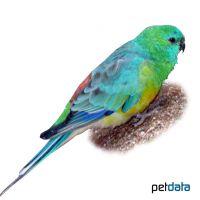Red-rumped Parrot (Psephotus haematonotus)
| Red-rumped Parrot Psephotus haematonotus | |
|---|---|
| Name | Red-rumped Parrot |
| Name Lat. | Psephotus haematonotus |
| Family | Elegant Parrots |
| Family lat. | Psittaculidae |
| Order | Parrots |
| Order lat. | Psittaciformes |
| Origin | Australia |
| Climate | Subtropical - tropical |
| Diet | Parrot seed, veggies, fruits |
| Keeping | Pair, group |
| Care Level | Easy |
| Reproduction | Cavity nest |
| Life Span | 15-20 years |
| Protection | CITES Appendix II; EC Annex B |
| Metric Units | |
| Size | 28 cm |
| Temperature | Room temperature |
| Housing | 200 x 100 x 100 cm |
| US Units | |
| Size | 11" |
| Temperature | Room temperature |
| Housing | 80" x 40" x 40" |
Distribution and habitat
The Sings Parakeets are native to southeastern Australia, where they live in open grassy landscapes with trees, fields, gardens and parks. They are only available as offspring since the export ban in 1960.
Cage size
The minimum cage size is 200 x 100 x 100 cm (L x W x H) for a pair. The cage size must not be undercut even in case of justified single keeping. For an additional 2 birds, assuming species compatibility, the floor space must be increased by 50%. The cage must be placed at a height of at least 80 cm (except aviaries) in a bright, draught-free and quiet place and should have cross-wiring or netting. Keeping in an aviary with a floor area of at least 3 m² is preferable to keeping in a cage.
Maintenance
The floor must be covered with sand, shavings of untreated wood or similar material and cleaned once a week if possible. At least 2 perches made of wood or branches of different thickness and height are to be installed in such a way that the longest possible flight path is created. They need a bathing opportunity and should also be sprayed with water occasionally (e.g. sprinkler system). Rings, ropes, and natural branches that are not harmful to health should be offered for occupation. They should be kept at room temperature.
Diet
The species-specific feed consists of mixed seeds. Ideal is a mixture of in the specialized trade available "Large parakeet feed" and "Forest bird feed" in premium quality, supplemented with cob millet, green fodder (chickweed, green panicle millet) and wild herb seeds, but only little vegetables, fruits and berries and especially for the Jungenaufzucht germinated seeds (wheat, millet), meal beetle larvae and egg fodder. If there are several animals, set up several feeding stations. They need grit, cuttlefish and vitamin lime as digestive aids. Water must always be available in birdbaths or in stable, open containers. Feed and water must be offered fresh daily, and the containers must be cleaned beforehand.
A varied diet promotes health and prevents deficiency symptoms.
Reproduction and breeding
In contrast to the males, the females are plain gray, brown or olive.
They breed in nest cavities made of softwood or in hollowed tree trunks. Bark mulch or sawdust from conifers is suitable as nest box bedding. The clutch consists of 5-7 eggs and the incubation period is about 19 days. The incubation period is from March to August, biologically speaking, when kept in an open aviary. During the breeding season they should be kept only in pairs (not in a group). Young birds should be raised so that they are species-specific.
Species protection
They should be provided with a leg ring. They are exempt from the obligation to notify (Federal Species Protection Ordinance Annex 5 to § 7 para. 2). Your pet store will be happy to provide you with further information.
Protection of species: WA appendix II; EU appendix B. The purchase receipt is the required proof of origin for the animal. Please keep it safe!
Important
In the case of outdoor aviaries, they also need a heated shelter of at least 1 m², which can be visited by the birds at any time. The temperature in the shelter must not fall below 5 °C and the furnishings must be the same as those used in cages
They may be kept only in pairs or in a group. Sufficient daylight or flicker-free artificial light (stroboscopic effect) corresponding to daylight must be provided in rooms, including shelters. The lighting duration shall be 8-12 hours per day and the natural day-night rhythm shall be observed. Adequate indoor climate should be provided. If caged, they should be allowed free flight. The health condition of the birds should be checked daily.
Further literature can be found in your pet store.
References
Text: Othmar Sieberer; Image: petdata
Source: BMELV (1995): Tierschutzgutachten - Mindestanforderungen an die Haltung von Papageien; ARNDT (1997): Lexikon der Papageien, Arndt Verlag; GRUMMT & STREHLOW (2009): Zootierhaltung - Tiere in menschlicher Obhut: Vögel, Verlag Harri Deutsch
- Gemäß § 21 Abs. 5 Tierschutzgesetz idgF
